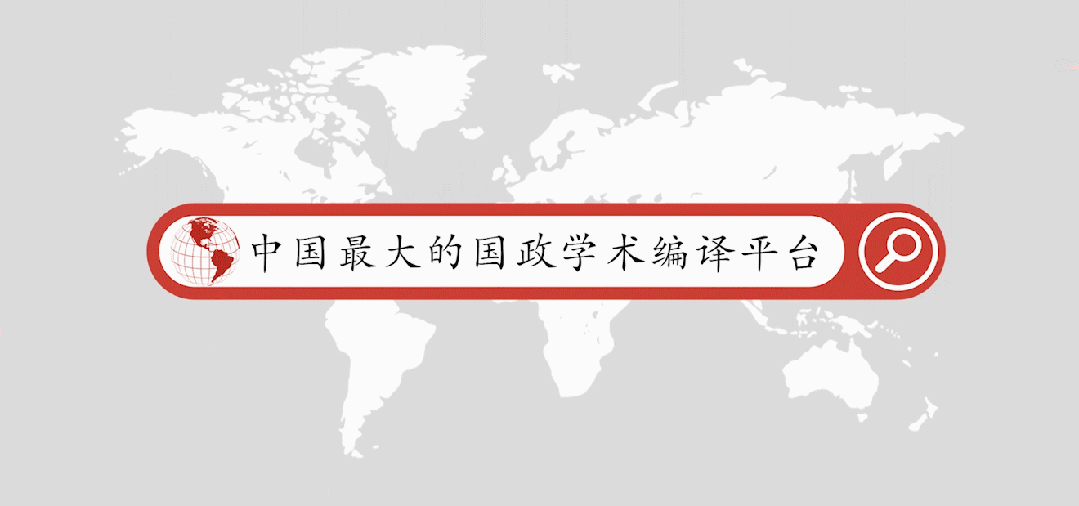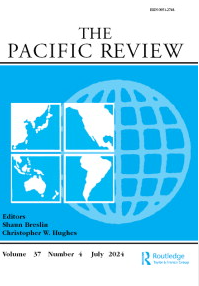
期刊简介

《太平洋评论》(The Pacific Review)是太平洋地区研究的主要平台,作为跨学科期刊,其宗旨和目标为打破研究领域之间以及学术界、新闻界、政府和商界之间的壁垒,重点关注政策问题。根据Journal Citation Reports显示,2021年该刊的影响因子为2.074。
本期目录
1
拥抱还是压制? 解释中国在国际事件中对民族主义的反应
Embrace or repress? Explaining China’s responses to nationalism in international incidents
2
非正式治理与中国在亚洲基础设施投资银行中的影响力
Informal governance and China’s influence in the Asian Infrastructure Investment Bank
3
萨德在东亚的技术政治
The Technopolitics of THAAD in East Asia
4
共同威慑还是单独威慑? 美日、美韩联盟的时间跨度与和平时期的联盟凝聚力
Deter together or deter separately? time horizons and peacetime alliance cohesion of the US-Japan and US-ROK alliances
5
超越“北方”与“南方”的僵局:谦逊的日本、全球南方的解放运动和西方精心设计的援助架构
Beyond the ‘North’-’South’ impasse: self-effacing Japan, emancipatory movements of the Global South and West-Engineered aid architecture
6
朝鲜气候外交:参与、优先事项和合作机会
North Korean climate diplomacy: engagement, priorities, and opportunities for collaboration
内容摘要
拥抱还是压制? 解释中国在国际事件中对民族主义的反应
题目:Embrace or repress? Explaining China’s responses to nationalism in international incidents
作者:连晨超,牛津大学政治与国际关系系博士生;Jianing Wang,伦敦国王学院全球事务学院刘氏中国研究所研究生。
非正式治理与中国在亚洲基础设施投资银行中的影响力
题目:Informal governance and China’s influence in the Asian Infrastructure Investment Bank
作者:刘宏松,上海交通大学国际与公共事务学院教授;吴桐,上海交通大学国际与公共事务学院博士研究生
摘要:本文构建了一个大国在国际组织中进行非正式治理的条件和机制的理论框架。它认为,非正式治理的条件是大国有有利的外部选择,即在不合作的情况下带来可观收益的替代方案,而其他国家则没有。当条件不具备时,大国就无法施加非正式的影响。本文基于大国在国际组织中非正式治理的条件和机制的理论视角,评估了中国在亚洲基础设施投资银行(AIIB)中的影响力。报告发现,中国在亚投行的影响力并非一成不变。亚投行成立初期,中国没有能力进行非正式治理,也没有在亚投行正式规则范围之外展示影响力。随着欧洲国家外部选择的恶化和中国外部选择的改善,中国在实施非正式治理方面处于有利地位。在这种情况下,中国的偏好很好地反映在亚投行的决策中。
This article develops a theoretical framework on the conditions and mechanisms of informal governance in international organizations by a major power. It argues that the condition for informal governance is that the major power has favourable outside options, i.e. the alternatives that bring about considerable gains in the absence of cooperation, while other countries do not. When conditions are not in place, the major power is unable to exert informal influence. Based on the theoretical lens of the conditions and mechanisms of informal governance by major powers in international organizations, this article assesses China’s influence in the Asian Infrastructure Investment Bank (AIIB). It finds that China’s influence in the AIIB does not remain static. In the early years after the establishment of the AIIB, China was not in a position to exercise informal governance and did not demonstrate influence beyond the confines of the AIIB’s formal rules. As the situation of outside options for European countries worsening and as China’s outside options improving, China became well placed to implement informal governance. Under such circumstances, China’s preferences are well reflected in the AIIB’s decision-making.
萨德在东亚的技术政治
题目:The Technopolitics of THAAD in East Asia
作者:Daniel Connolly,韩国外国语大学国际学系副教授
摘要:2016年,韩国政府决定部署末段高空区域防御系统(THAAD),引发了国内外的强烈抗议。通过展示萨德系统的“真相”来解决这些争论的尝试,掩盖了在面对敌对解释时稳定技术含义所需的大量时间和资源的投入。本文综合了科学技术研究(STS)领域的工作,提出了一个技术政治的综合模型以解释如何通过由相互关联的修辞、表演和物质上的稳定技术组成的“事物”来进行政治活动,其中每一种技术都试图使对象变得简单、非政治,最终变得无形或平庸。就萨德而言,部署在韩国的单一系统是美国一项更广泛的技术政治项目的一部分,目的是在实质上团结其地区盟友,遏制朝鲜和中国。然而,朝鲜半岛内外的反对者试图利用他们自己的修辞、表演和非物质化策略来破坏此项目的稳定。这导致了双方的部分胜利,因为美国在朝鲜半岛上更广泛的导弹防御技术政治项目只是被暂停,而没有彻底失败。
The decision by South Korean authorities to deploy a Terminal High Altitude Area Defense (THAAD) missile battery in 2016 unleashed a storm of protest, both domestically and internationally. Attempts to resolve these debates by showing the ‘truth’ of the THAAD system obscure the considerable investment of time and resources needed to stabilize technological meanings in the face of rival interpretations. This article synthesizes work in the field of Science and Technology Studies (STS) to present an integrated model of technopolitics explaining how doing politics through ‘things’ consists of interlinked rhetorical, performative, and material stabilization techniques each seeking to make the object simple, nonpolitical, and ultimately invisible or banal. In the case of THAAD, the single battery deployed to South Korea was the tip of a broader US technopolitical project to materially bind together its regional allies and contain North Korea and China. However, opponents inside and outside of the Korean peninsula tried to destabilize this project by employing their own rhetorical, performative, and de-materialization strategies. This resulted in a partial victory for both sides insofar as the broader US missile defense technopolitical project on the peninsula was paused but not defeated.
共同威慑还是单独威慑?:美日、美韩联盟的时间跨度与和平时期的联盟凝聚力
题目:Deter together or deter separately? time horizons and peacetime alliance cohesion of the US-Japan and US-ROK alliances
作者:Do Young Lee,奥斯陆大学政治学系助理教授
摘要:如何解释和平时期联盟凝聚力的程度?为什么一些联盟在面对共同的外部威胁时保持凝聚力,而另一些却没有?本文认为,盟友针对特定威胁的时间范围的相互作用决定了盟友在威慑共同威胁方面是否具有凝聚力。本文证明了盟国对共同威胁的行为取决于其特定威胁的时间范围的长度,这可以区分为“短”或“长”。基于这一论证,作者预测,当盟友的时间跨度彼此一致时,就会呈现出高度的联盟凝聚力,而当它们不一致时,就会出现较低的联盟凝聚力。为了系统地衡量盟友的时间跨度,文中提出了一种新的类型学。为了验证这一观点,作者对过去二十年来和平时期为应对中国的崛起的美日、美韩联盟的凝聚力进行了跨案例分析。
What explains the degree of peacetime alliance cohesion? Why do some alliances maintain cohesion regarding common external threats while others do not? I argue that the interaction of allies’ threat-specific time horizons determines whether allies are cohesive or incohesive in deterring common threats. I demonstrate that allies’ behavior towards common threats differs depending on the length of their threat-specific time horizons, which can be categorized as either ‘short’ or ‘long.’ Based on this demonstration, I predict that high alliance cohesion occurs when the lengths of allies’ time horizons are mutually congruent, whereas low alliance cohesion occurs when they are incongruent. To systematically measure allies’ time horizons, I propose a novel typology. To test my argument, I conduct cross-case analyses of peacetime alliance cohesion in the US-Japan and US-ROK alliances over the past two decades in response to the rise of China.
超越“北方”与“南方”的僵局:谦逊的日本、全球南方的解放运动和西方精心设计的援助架构
题目:Beyond the ‘North’-’South’ impasse: self-effacing Japan, emancipatory movements of the Global South and West-Engineered aid architecture
作者:Sabina Insebayeva,纳扎尔巴耶夫大学政治科学与国际关系系助理教授
摘要:这篇文章有三个目的。首先是重新审视“全球北方”/“全球南方”和“北方”捐助者/“南方”提供者这样理所当然的分类,并对日本在西方主导的援助体系中所扮演的角色提出了另一种解释。其二是研究为何日本通过适应经合组织-发展援助委员会和南南合作规范构建了一个“自成一体的”援外模式。最后,通过强调学术辩论未能抓住以1955年万隆会议为代表的全球南方解放运动对日本援助政策的重要性,本文旨在借此解释日本特殊的援助模式是如何成为可能的。
The article has three objectives. The first is to reconsider the popular taken-for-granted categories of ‘Global North’/’Global South’ and ‘Northern’ donors/’Southern’ providers and proposes an alternative account for examining Japan’s role in West-engineered aid architecture. The second is to examine why Japan has constructed a ‘sui generis’ foreign aid model by accommodating both the OECD-DAC and SSC (South-South Cooperation) norms. Finally, this article aims to explain how Japan’s alternative aid modality was possible by highlighting that the academic debate has failed to capture the significance of the emancipatory movements of the Global South epitomized by the 1955 Bandung Conference for Japan’s aid policy.
朝鲜气候外交:参与、优先事项和合作机会
题目:North Korean climate diplomacy: engagement, priorities, and opportunities for collaboration
作者:Cesare M. Scartozzi,生物多样性与国际农业研究进展联盟博士后研究员;Gordon Kang,新加坡南洋理工大学拉惹勒南国际研究院高级分析师
摘要:本研究通过内容和情感分析,分析了39份政策文件和93439篇新闻文章的综合数据集,对朝鲜的气候外交进行了调查。该研究旨在深入了解该国的气候外交方法、框架和优先事项。研究结果显示,朝鲜的气候外交主要是由物质利益驱动的,重点是减少损失和损害、获得气候融资和技术转让。该研究突出了朝鲜气候变化话语中的关键主题,如经济因素、人类安全以及令人惊讶的非意识形态立场。情绪分析还表明了其对国际社会的合作态度和对《联合国气候变化框架公约》机制的大力支持。研究结果为未来的外交努力提供了宝贵而微妙的启示,为与朝鲜在气候变化问题上的合作和接触提供了潜在的途径。尽管如此,该研究也指出了外交接触的几个障碍,比如朝鲜不愿接受与气候融资相关的某些条件,以及备受争议的朝鲜将核能作为减缓气候变化工具。总的来说,这项研究有助于不断增加气候外交方面的文献,并为朝鲜外交政策中一个未被探索的方面提供了新视角。
This study investigates North Korea’s climate diplomacy by analyzing a comprehensive dataset of 39 policy documents and 93,439 news articles through content and sentiment analysis. The research aims to provide insights into the country’s climate diplomacy approach, framing, and priorities. The findings reveal that North Korea’s climate diplomacy is primarily driven by materialistic interests, focusing on loss and damage reduction, access to climate finance, and technology transfers. The study highlights key themes in North Korea’s climate change discourse, such as economic factors, human security, and a surprisingly non-ideological stance. The sentiment analysis also indicates a collaborative approach toward the international community and strong support for UNFCCC mechanisms. The results offer valuable and nuanced implications for future diplomatic efforts, suggesting potential avenues for collaboration and engagement with North Korea on climate change issues. Nonetheless, the study also identifies several barriers to diplomatic engagement, such as North Korea’s reluctance to accept certain conditionalities associated with climate finance as well as its contentious focus on nuclear energy as a climate mitigation instrument. Overall, this research contributes to the growing literature on climate diplomacy and sheds new light on an underexplored aspect of North Korea’s foreign policy.
编译 | 任雨欣
审校 | 张潇文
排版 | 刘雪莹
本文源于《太平洋评论》,本文为公益分享,服务于科研教学,不代表本平台观点。如有疏漏,欢迎指正。

